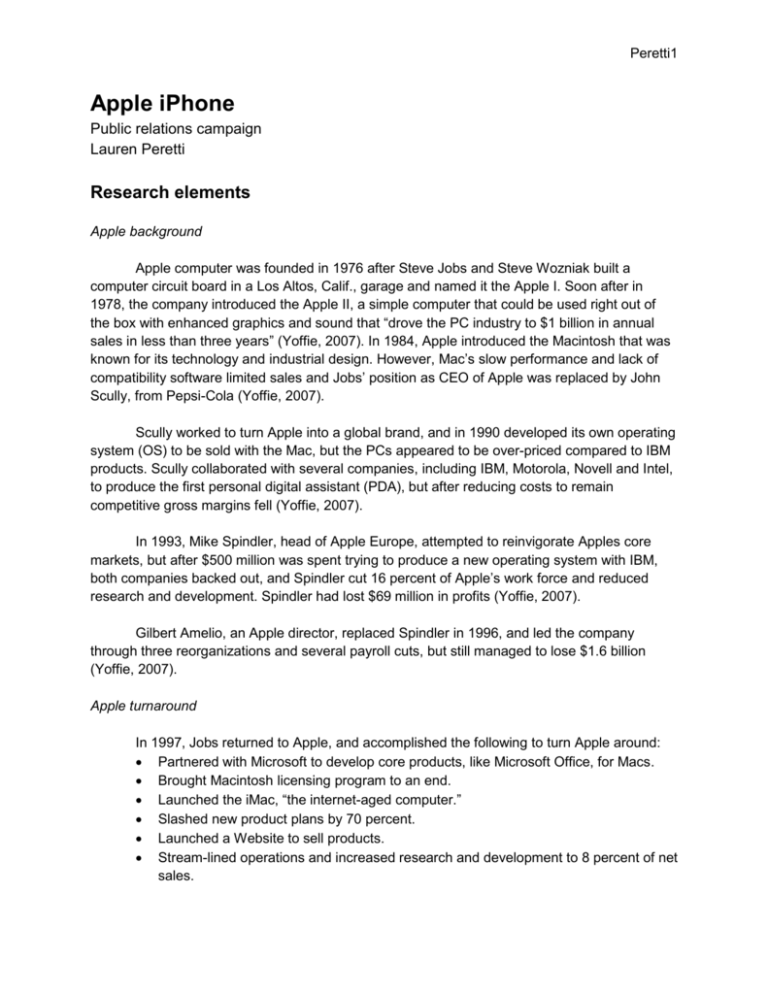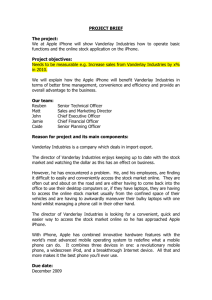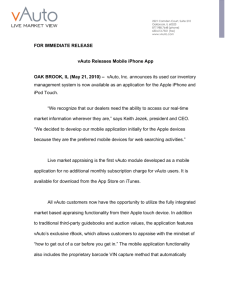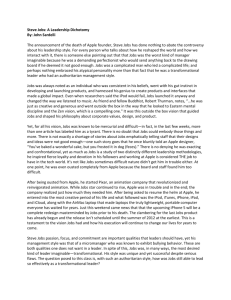
Peretti1
Apple iPhone
Public relations campaign
Lauren Peretti
Research elements
Apple background
Apple computer was founded in 1976 after Steve Jobs and Steve Wozniak built a
computer circuit board in a Los Altos, Calif., garage and named it the Apple I. Soon after in
1978, the company introduced the Apple II, a simple computer that could be used right out of
the box with enhanced graphics and sound that “drove the PC industry to $1 billion in annual
sales in less than three years” (Yoffie, 2007). In 1984, Apple introduced the Macintosh that was
known for its technology and industrial design. However, Mac’s slow performance and lack of
compatibility software limited sales and Jobs’ position as CEO of Apple was replaced by John
Scully, from Pepsi-Cola (Yoffie, 2007).
Scully worked to turn Apple into a global brand, and in 1990 developed its own operating
system (OS) to be sold with the Mac, but the PCs appeared to be over-priced compared to IBM
products. Scully collaborated with several companies, including IBM, Motorola, Novell and Intel,
to produce the first personal digital assistant (PDA), but after reducing costs to remain
competitive gross margins fell (Yoffie, 2007).
In 1993, Mike Spindler, head of Apple Europe, attempted to reinvigorate Apples core
markets, but after $500 million was spent trying to produce a new operating system with IBM,
both companies backed out, and Spindler cut 16 percent of Apple’s work force and reduced
research and development. Spindler had lost $69 million in profits (Yoffie, 2007).
Gilbert Amelio, an Apple director, replaced Spindler in 1996, and led the company
through three reorganizations and several payroll cuts, but still managed to lose $1.6 billion
(Yoffie, 2007).
Apple turnaround
In 1997, Jobs returned to Apple, and accomplished the following to turn Apple around:
Partnered with Microsoft to develop core products, like Microsoft Office, for Macs.
Brought Macintosh licensing program to an end.
Launched the iMac, “the internet-aged computer.”
Slashed new product plans by 70 percent.
Launched a Website to sell products.
Stream-lined operations and increased research and development to 8 percent of net
sales.
Peretti2
Rehired TBWA Chiat/Day, the agency that designed the original Mac advertising, to
develop a campaign to promote Apple as a “hip” alternative to other brands.
Launched Mac OS X operating system in 2001.
Developed Safari Web browser.
Migrated toward standard interfaces (USB ports) making Mac a less closed system.
Incorporated Intel chips into Macs (Yoffie, 2007).
Computer market
Apple pioneered the first usable personal computing devices, and IBM brought the PCs
to the mainstream. By 2005, there where nearly 900 million PCs in the world and among them
were desktops, laptops, notebooks, sub-notebooks, workstations and servers. Many
manufacturers were building-to-order PCs to reduce costs, and competitors included Dell,
Hewlett-Packard, Lenovo, and IBM (Yoffie, 2007).
iPods
In 2003, Apple introduced the iPod, a premium portable digital music player based on
MP3 compression standard, and later developed an entire line. At the start, the iPod could only
work with Macs, but soon a new model was developed to be compatible with Windows.
Following its launch, was the introduction of the iTunes music store, an online service provided
by Apple for consumers to purchase songs to download onto their iPods (Yoffie, 2007).
Situation analysis
Apple is a unique, innovative company because it makes its own hardware, operating
system, programs, consumer-electronic devices, and runs an online service. Most recently, the
company tried to partner with wireless phone service providers to develop an iTunes phone, but
efforts failed (Yoffie, 2007). Jobs has just announced the development of an iPod phone, under
the name iPhone, and has asked the public relations director of Chiat/Day to develop a public
relations campaign for the launch of the latest Apple invention.
SWOT defined
Strengths
Cutting edge technology in a sleek design
Variety of features appeal to vast audience
Can be personalized by consumer’s interests
Weaknesses
Premium price
Offered only through AT&T service providers
Peretti3
Opportunities
Make iPhone central to emerging digital lifestyle
Place Internet features into consumer hands
Threats
Consumers do not understand features
Is not perceived as “easy to use” product
Too much technology
Public relations
“Public relations is the management of relationships between a company and its various
publics or stakeholders including media, employees, government, community leaders, and the
investment community” (Mezera, 2008). Many companies today use public relations campaigns
to increase publicity and brand awareness, as opposed to advertising which is more costly and
less credible.
Public relations includes:
Face-to-face communications tactics
o Special events, group meetings, exhibits, demonstrations
Organizational media tactics
o Newsletters, brochures, posters, Web sites, intranet, e-mail, chat rooms, blogs,
mobile phones, social networking, letters, video, photography, annual reports,
logos, etc.
News media tactics
o Press releases, video news releases, media alerts, news conferences, fact
sheets, feature stories, press kits, media tours, op-ed guest columns, etc
(Swann, 2008).
Recommendation
Objectives
Develop publicity and product awareness for the Apple iPhone by reaching a young audience
interested in the latest integrated mobile technology, as well as business professionals in the
workplace with little paid advertising.
Strategies
Differentiate iPhone and define its easy to use, technologically advanced features.
Execute a media campaign designed to communicate the importance and value of
cutting edge, mobile technology in an integrated design.
Frame product launch using an information platform to serve as message point to
communicate product benefits.
Peretti4
Leverage “hip” celebrities and business professionals to serve as credible third-party
spokespeople.
Use tips from spokespeople and explanation of their favorite features and applications .
Tactics
Press releases
o Use informational/educational platform to explain the features that the iPhone is
equip with.
o Announce spokespeople and dates of media tour, exhibits, etc.
o Call-to-action: Web site for visual demonstration and more on applications.
Press kit
o Fact sheet detailing features, technology, efficiency, cost, company mission, etc.
o Compact disc with visual representation of iPhone demonstration of features.
o Testimony of spokespeople.
Brochures
o In-store- pass out to consumers; direct mail- send to previous Apple purchasers
Emphasize sleek design and easy to use, various features.
Versatility in office, at home and on the go.
Appeal to young, tech-savvy adults and novice to expert business
professionals.
Posters
o In-store
Visually appealing graphics that portray the sleek product design, touch
screen clarity, and various applications.
“Coming soon” tag line.
Spokespeople
o Hip celebrity: singer, actress, comedian
Use testimonies and demonstrations to show features that appeal to them
and suggest it is the latest, “hip” product.
Spotlight applications
E.g. singer likes iTunes, check weather for next concert, see
where their tour bus is traveling; actress watches movies, reads
scripts sent from agent.
o Business professional: Fortune 500 CEO, company president, young associate
Use testimonies and demonstrations to show features that appeal to them
and suggest it is a serious business tool.
Spotlight applications
E.g. calendar, Microsoft Exchange, appointment scheduler,
transfer work documents from PC to phone and take on business
trips.
Web site
o Develop a Web page located on the Apple Web site that details the product,
gives video and audio demonstrations, features spokespeople testimonies
showing consumers their favorite applications.
Peretti5
o
Call-to-action for public relations materials should send consumers to Web site
for more information.
o Sign up for e-mail/mobile announcements for new applications.
o Order online, be the first to have one.
Mobile phones
o AT&T
Collaborate with AT&T mobile service to feature the product in stores, on
Web site, and word-of-mouth by associates.
Use interactive media to send announcements to current AT&T
subscribers of product launch and features.
Enter to win a free iPhone, send to Web site.
Social networking
o Develop groups excited about the coming of the iPhone to initiate discussion of
its features.
o Feature ads on the sites.
E-mail
o Send e-mails to previous Apple consumers announcing the product.
o Spotlight phones various applications weekly up to and for some time after
launch.
Blog
o Develop a blog with spokespeople to talk directly with consumers to about the
features the iPhone has and how it has improved their life.
o Consider suggestions for applications.
Demonstrations
o In-store demonstrations at Apple and AT&T.
o Exhibition demonstrations at technology, mobile phone and internet conferences
world-wide.
Special event
o Develop extremely oversized interactive iPhone to display in Times Square
Phone would appear on the side of a building, should rotate and include
all the features of the iPhone.
A business-dressed and trendy-dressed stunt person would be
suspended from bungees and on platforms to reach and move across
display.
Interactive display would allow stunt people to use the features of the
touch screen phone by jumping and hitting it.
Periodically it would rotate to show the screen automatically does to.
When stunt people were not on site, the phone would automatically show
features.
o Shows easy to use features even in a difficult situations
National media tour
o Send Apple iPhone bus across nation stopping in major cities to talk to people
about the new phone (word-of-mouth).
o Hold news conferences with spokespeople.
Peretti6
References
Kerin, R. A., & Peterson, R. A. (2007). Strategic marketing problems (11th ed.). Upper Saddle
River, NJ: Pearson Prentice Hall.
Mezera, C. (2008, August 18). Lesson 7: Public relations in IMC. Retrieved September 22, 2008
from eCampus: Assignments & Lessons website:
https://ecampus.wvu.edu/webct/urw/lc5116001.tp0/cobaltMainFrame.dowebct. P.I. Reed School
of Journalism, WVU.
Swann, P. (2008). The case method. Cases in Public Relations Management. (pp. 34-35). ,
New York: McGraw Hill.
Yoffie, D.B., & Slind, M. (2007). Apple computer, 2006. Harvard Business School, 9706496, 125.








